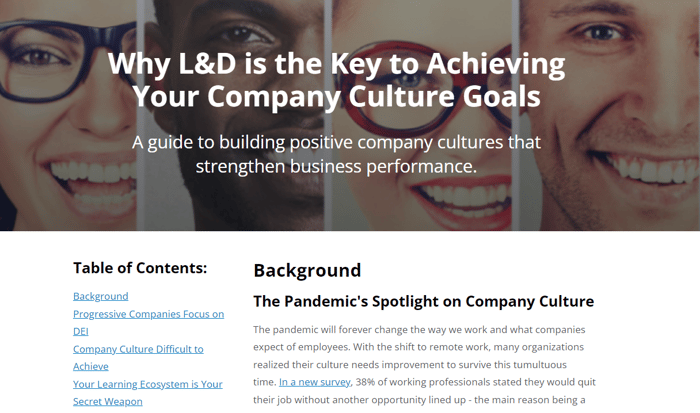
Web pages, blogs, landing pages, and pillar pages. There are so many different types of content for SaaS websites. It can be confusing to understand each page type and why it's essential to use each one in your web content strategy.
The pillar page stands out amongst the rest when discussing growing organic traffic and increasing engagement. Pillar pages can increase traffic, conversions, and overall user experience when done correctly.
Let's unpack this topic a bit.
What is a Pillar Page?
Pillar pages are in-depth guides that aim to thoroughly discuss a topic, answer concerns about it, and serve as a center of other related content on your website. These detailed site pages usually represent the most important topics to your organization and introduce similar related topics to your audience.
Pillar pages are long-form pieces of content that are ungated but lead to downloadable versions of the same or similar content and shorter complimentary content. These form a “topic cluster”.
The heart of "topic clusters," used to organize website content, are pillar pages. Let's take a closer look.
What are Topic Clusters?
Topic clusters are collections of information that revolve around a primary theme and connect to and from a pillar page. In a nutshell, topic clusters are focused on a subject and provide internal linking opportunities.
Your topic cluster should begin with a solid long-form piece of content (a pillar page) and then link to all of the relevant cluster topics on your site. These relevant topics often include blog articles as well as product pages.
The topic cluster model will give you the following benefits:
A content structure to replicate in the future: You likely have multiple essential topics related to what your business sells. With lean organizations, it's necessary to figure out how to replicate strategies that work at scale. Using a topic cluster model allows you to do that.
Improved SEO: Interlinking topics to your pillar page and blog will increase your SEO by giving your page authority on the topic you are highlighting.
Pillar Page vs. Landing Pages, What's the Difference?
Marketers use many different types of web pages, but two of the most common are landing pages and pillar pages.
What's the difference, and do you need to use both?
A pillar page is long-form content designed to be the resource on a single topic. It will organically bring people to your site and keep people engaged by linking to other pages throughout your site. This strategy will also help SEO by giving your page authority on a specific topic the pillar highlights.
A landing page promotes a single offer—for example, it can promote a whitepaper, entice a prospect to schedule a demo, or advertise a webinar and request registration. Landing pages are leveraged throughout your website and advertising to get prospects to convert (give up their email and other information) on the form.
Pillar pages and landing pages can convert prospects that find the pillar page through your SEO efforts. Pillar pages will usually offer a PDF version of the content people can download to read later. A CTA will lead to a landing page where people can provide their contact information in return for the pdf version.
Creating Landing Pages? Get the Ultimate Landing Page Checklist!
Pillar Pages and Blog Posts
Blog posts are also website pages, but in the form of articles typically housed under your "blog" or website content repository. In the old days, your blog was the place for all your company news and articles, as well as other topics about what your company sells, and anything else for that matter. In current days, we still use blogs the same way, but many times we use blogs to house supporting articles to pillar page content.
We link supporting blog articles to pillar pages, include CTAs to the downloadable content format for the pillar page long content in the blog post, and also link the pillar page back to the supporting blog posts. This is a sold "interlinking" SEO strategy.
Why Should You Create Pillar Pages?
Gone are the days when you could load up content with keywords. Google found years ago that keyword-stuffing content is not the type of content users search. Your prospects want quality content and Google enforces this premise.
The idea of a topic cluster with the pillar page as the “hub” and blog posts as the “spoke” will help more of your pages rank by giving searchers better content. Since pillar pages don’t stand on their own and link to other related pages, they signal to search engines that your organization has authority on a topic.
Pillar pages also serve as a way to organize your website's content. By creating topic clusters, you can ensure all pages lead to specific goals around your business priorities.
With the improved organization of topics and increased traffic because your site has improved SEO with pillar pages, capturing leads from this effort makes sense. Every pillar page should have CTA's and popups that convert prospects to leads on landing pages.
Pillar Page Examples
We're big believers in pillar pages and have managed to get a Google snippet on numerous topics for our clients using this strategy. There is no one size fits all to get a snippet, but creating a pillar page that thoroughly covers your topic and supporting blog content is a great start.
There are many types of pillar pages, but here are a few of the common ones:
An Ebook

A Guide

Key Insights

Where to go From Here?
We understand the most challenging part of executing a strategy is figuring out where and how to start! So, we’ve created multiple resources and checklists to help organizations like yours jump-start your demand generation. We recently completed an Ultimate Checklist for Creating Pillar Pages and Matching Ebooks to help you create your pillar page strategy.
There are many little tasks associated with creating a pillar page and ebook. Download the checklist for a full list!
